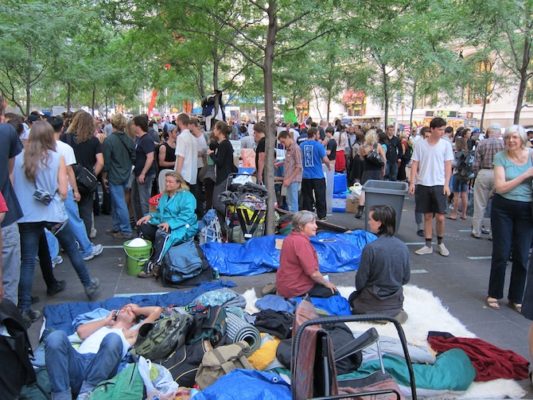Search
To search for an exact match, type the word or phrase you want in quotation marks.
A*DESK has been offering since 2002 contents about criticism and contemporary art. A*DESK has become consolidated thanks to all those who have believed in the project, all those who have followed us, debating, participating and collaborating. Many people have collaborated with A*DESK, and continue to do so. Their efforts, knowledge and belief in the project are what make it grow internationally. At A*DESK we have also generated work for over one hundred professionals in culture, from small collaborations with reviews and classes, to more prolonged and intense collaborations.
At A*DESK we believe in the need for free and universal access to culture and knowledge. We want to carry on being independent, remaining open to more ideas and opinions. If you believe in A*DESK, we need your backing to be able to continue. You can now participate in the project by supporting it. You can choose how much you want to contribute to the project.
You can decide how much you want to bring to the project.

The latest issue of October magazine was dedicated to reflecting on whether the movement Occupy Wall Street has had any influence on the world of art. On 17 September 2012 it was a year since the American version of the global calls for a change in the relations between states and the financial system began, with the occupation of the Zuccotti Park in New York. October has wanted to weigh up whether this movement left any impact on contemporary art.
Since the sixties, the academic publication October has formed the backbone of thought within a history of art that has slowly assimilated European and North American postmodern critical theory. For this issue, David Joselit and Carrie Lambert-Beatty, professors in the Art History departments of Yale and Harvard, sent out a questionnaire to a group of personalities within the ambit of American art linked to the movement. The tactic is not new, given that October every now and again uses the format of the questionnaire to take the temperature of debates that are relevant within the field (like, for example, the one that was sent out about visual studies in 1996, or the one that was dedicated to thinking about how to define contemporary, in 2004). In this case, the questions sent out to the contributors aimed to come to a certain consensus about the characteristics, aesthetics and policies of OWS. In order to do so they were asked how the experience had affected their personal life and their political activities. From the answers obtained, as well as from two other articles and a conversation, some points can be drawn that can be understood to be what the editors present as worth mentioning in the relation between OWS and the art of today.
There are three common points in the majority of the interventions. Firstly, almost all coincide in indicating what are the precedents of the movement. It seems necessary, therefore, to present it not just as a contemporary global phenomenon, but also as one more milestone in this narrative of the history of modern and contemporary art, articulated by way of an inventory of the exercises of political art practices that have arisen in each decade, as if this practice was inseparable from the work of the artist the rest of the time. According to the contributors to this issue of October, Occupy Wall Street is indebted to the Arab spring, the movements of the indignados in Spain and the riots in Greece. But there are also those who reinforce its radical nature within the political history of the American continent, indicating the importance of the assemblies of the Zapatistas, the Cuáqueros and Native Americans as formal referents for the organisation of the movement. Surprisingly, even though frequent mention is made of the French May68, no one endeavours to link the activity of the artists and activists in 2011 with the work of the AmericanArt Workers Coallition of 68, a collective that was actually active in the city of New York. Referred to in the issue solely as the framework for the piece Anatomic Explosion in Wall Street (Kusama, November 1968), a more detailed development of the real repercussions that this syndicate of artists had on the policies of institutions such as MoMA would have served, in this case, to establish a barometer with which perhaps to contrast the imprint that OWS might in effect have left on the global art system. In this sense there is also no allusion in the issue to the occupy action in the last Berlin Biennale (see Saioa Olmo’s interview with Artur Zmijewski in the 99th issue of this magazine) that was an intent to activate the energies of the movement within an artistic institution, the effectiveness of which was left in the balance, with it receiving all sorts of criticisms this summer.
The second of the points in common in almost all the texts is the tendency to let the other speak. A gesture, that in a few cases contributes to making the debate, that this issue of the magazine aims to create, even denser. A third of those to whom the questionnaire was sent act as proxy figures between October, the large institutions and those who in principle were not asked for any explanation, students and artists. Others cite the verses of poets, already established standard bearers in the fight for liberty in past revolutions. Despite the fact that this venture to provide representation to different voices could suppose a timid act of activism within the institution, what it manages to do is limit many of the testimonies to narratives about the day to day activities of an activist artist in OWS, which could be interesting but ends up lending form to an almost documentary repertoire of modus vivendi for activism that doesn´t propose any answers to the initial intention of the issue: to understand how a political experience of this type affects the discourse of the art academy. If the magazine really wanted to explore this problem, for the time being their methodology has failed. But then maybe it merely sought to identify it.
However, there are various strong points in the issue. The third element repeated in many of the contributions is the question about the power of the movement to configure new aesthetic paradigms. J. Mansoon, D. Marcus and D. Spaulding, from the world of academia, identify in OWS the reactivation of the problem of autonomy within the aesthetic debate. They reject the notion of autonomy, as much as that of economic self-management and the reading of this in terms of Adorno. While on the contrary as an alternative they call for sustained autonomy in the practice of the present, where relations between bodies and things are subject to permanent negotiation. In conclusion, an autonomy as an exercise rather than a likely post-revolutionary future. Along these lines, Rosalyn Deutsche rescues Vito Acconci’s definition of public art, “to construct or break a public space”, and reminds us of the need not to forget that the city is the product of the violence present in all cohabiting with another. The public space is not the framework in which we live so much as an ambient medium that is the confrontation of the diversity of each of our practices – something that sounds discordant with a certain overrating of the consensus within the movement. The working group Alternative Economies, stemming from the art and work sections of Occupy Wall Street, asks the issue’s readers what mechanisms would enable them to broaden the reach of the work of the individual artist to wider ranging networks, for it to function not solely as a nexus with the public so much as to assume a new utility within the community. In the round table, The Social Artwork, they also ask about the changing functions of the artistic product; in what direction will the professions of artist, curator, critic, etc., lead? Does the tendency seem to lean towards activism? Does it make any sense to talk of disciplines?
Ultimately, none of the contributions that appear in this issue offer anything very innovative. The aesthetic is mutating, but it is not due to the contributions that the activism of OWS might have made up until now. The aftertaste that the issue leaves is bittersweet, unbalanced between snippets that had something one could really get one’s teeth into, that hopefully will be developed in later volumes, and contributions celebrating the plurality of figures that make up OWS, but that copy attitudes towards the art-politics coupling that are more typical of the readings of Marcuse that the discipline made in the seventies. The emancipation of art from what the movement identified as its participation in financial capitalism doesn´t come from experiences like the ones that are analysed here. So why does October dedicate an issue to considering whether there are answers to this question? In the founding manifesto of the magazine, in 1976, Rosalind Krauss and Annette Michelson declared as an objective of the publication to initiate a series of re-examinations of historic events, in order to analyse the roles of the various arts in the social context marked by these conflicts. I would like to believe that this issue, as Maurice Blanchot said in 1968, “is a simple act of speaking made at a time when it needed to be made”. Does October think that OWS can end up having a real effect on art? We don’t know if this latest issue has been a gesture that responds in affirmative to this question or if on the contrary it has been a gesture of responsibility within the context. What is clear is the 2012 fall issue October has been true to its editorial line.

Paloma Checa-Gismero is Assistant Professor at San Diego State University and Candidate to Ph.D. in Art History, Criticism and Theory at the University of California San Diego. A historian of universal and Latin American contemporary art, she studies the encounters between local aesthetics and global standards. Recent academic publications include ‘Realism in the Work of Maria Thereza Alves’, Afterall, autumn/winter 2017, and ‘Global Contemporary Art Tourism: Engaging with Cuban Authenticity Through the Bienal de La Habana’, in Tourism Planning & Development, vol. 15, 3, 2017. Since 2014 Paloma is a member of the editorial collective of FIELD journal.
"A desk is a dangerous place from which to watch the world" (John Le Carré)